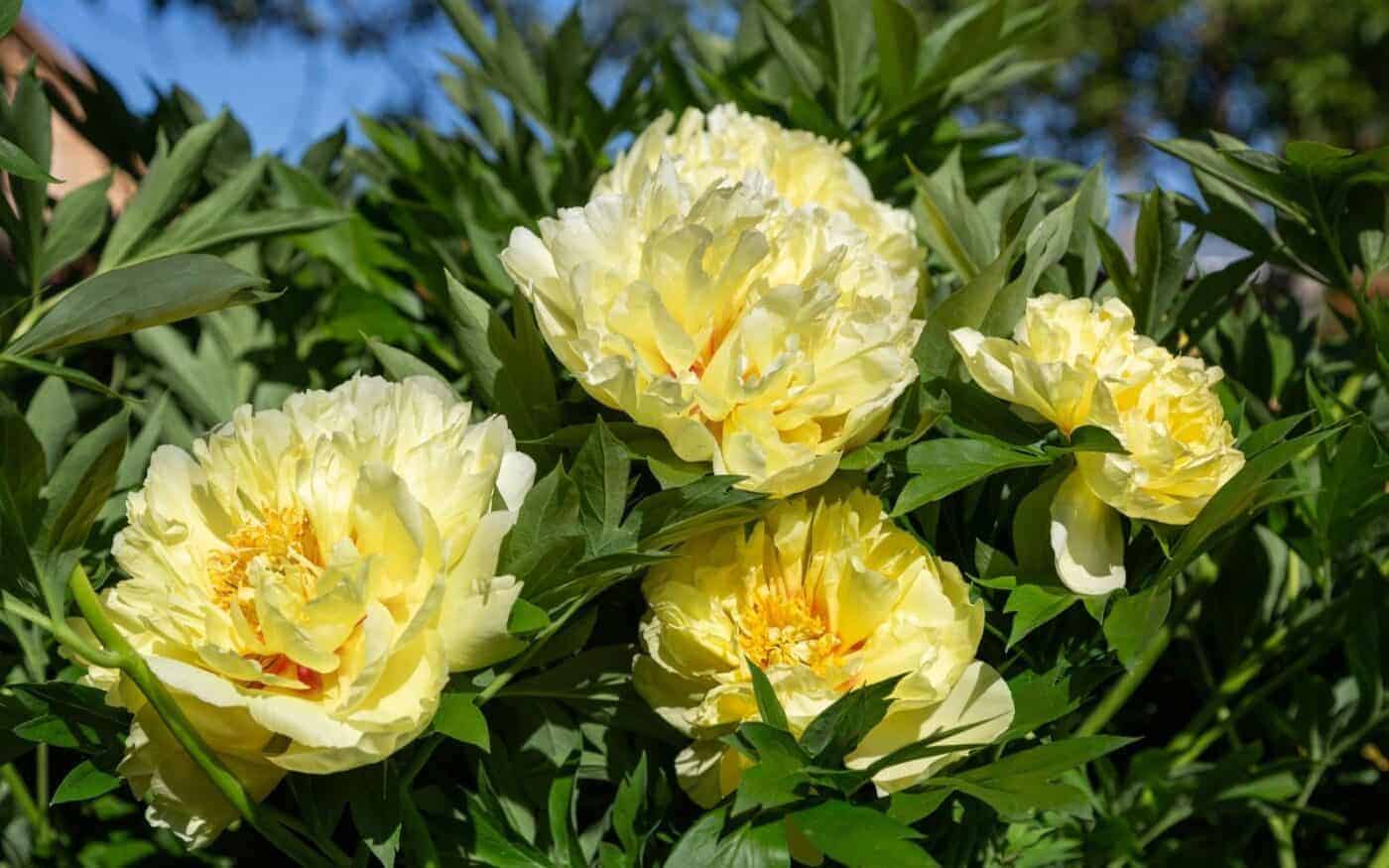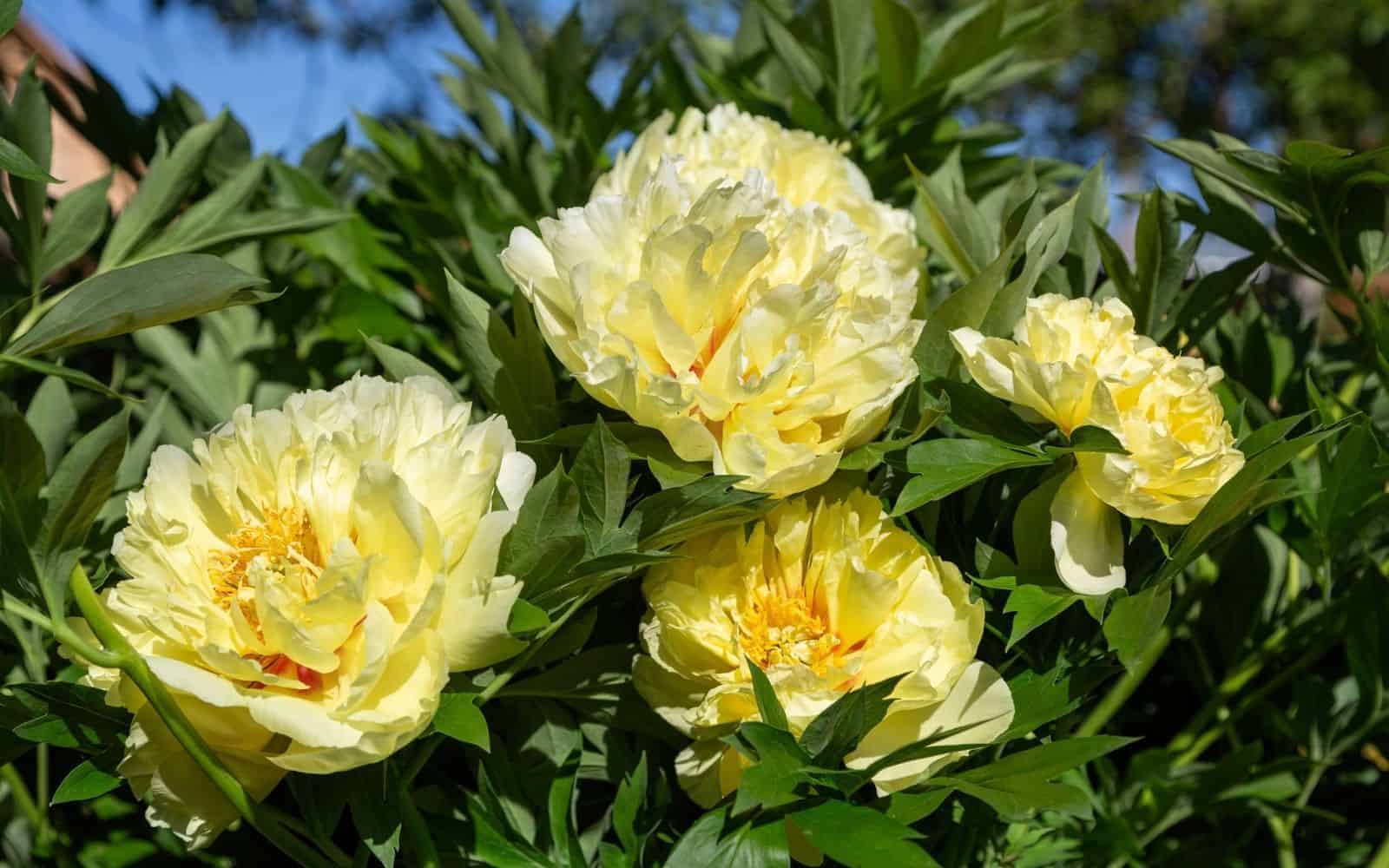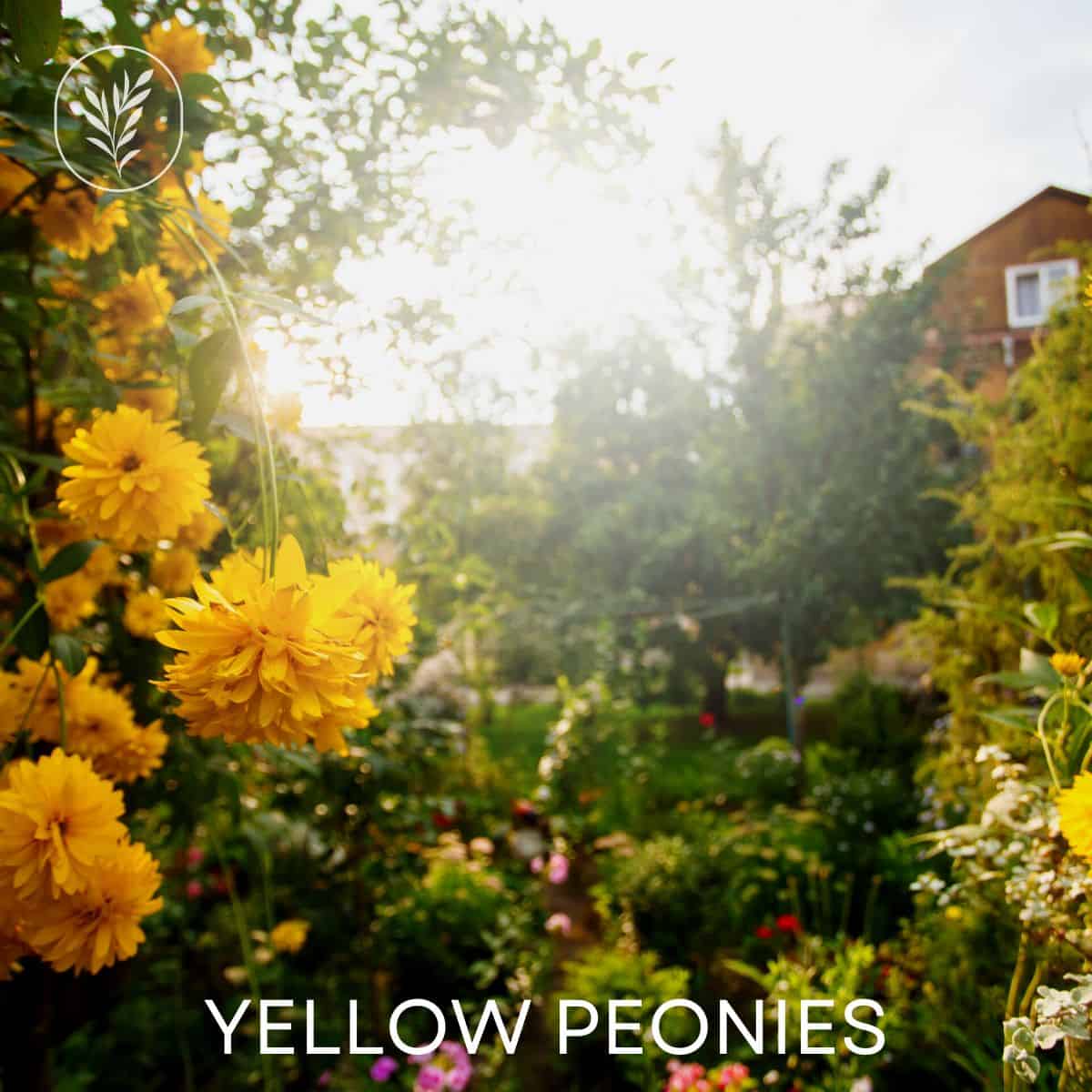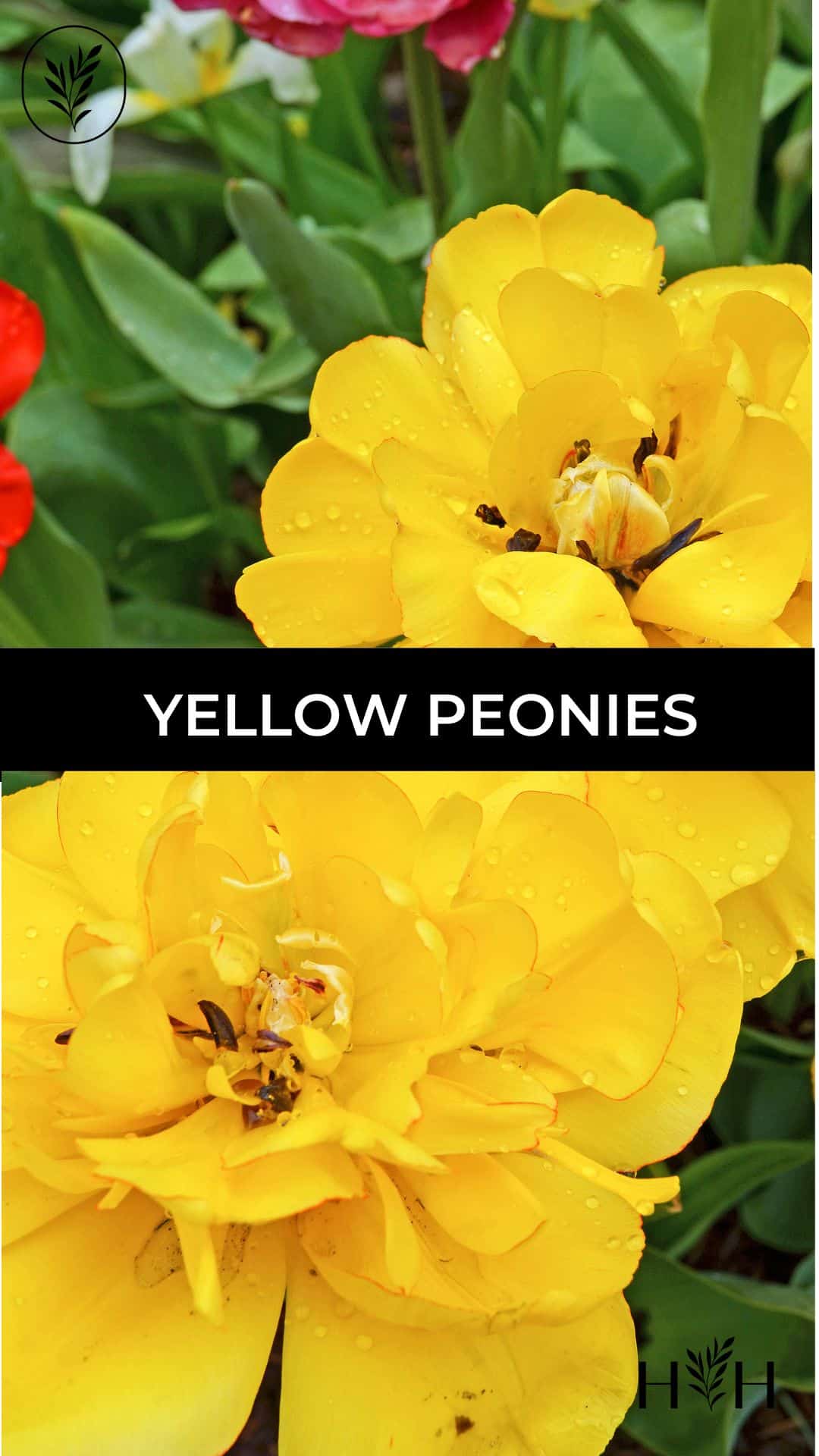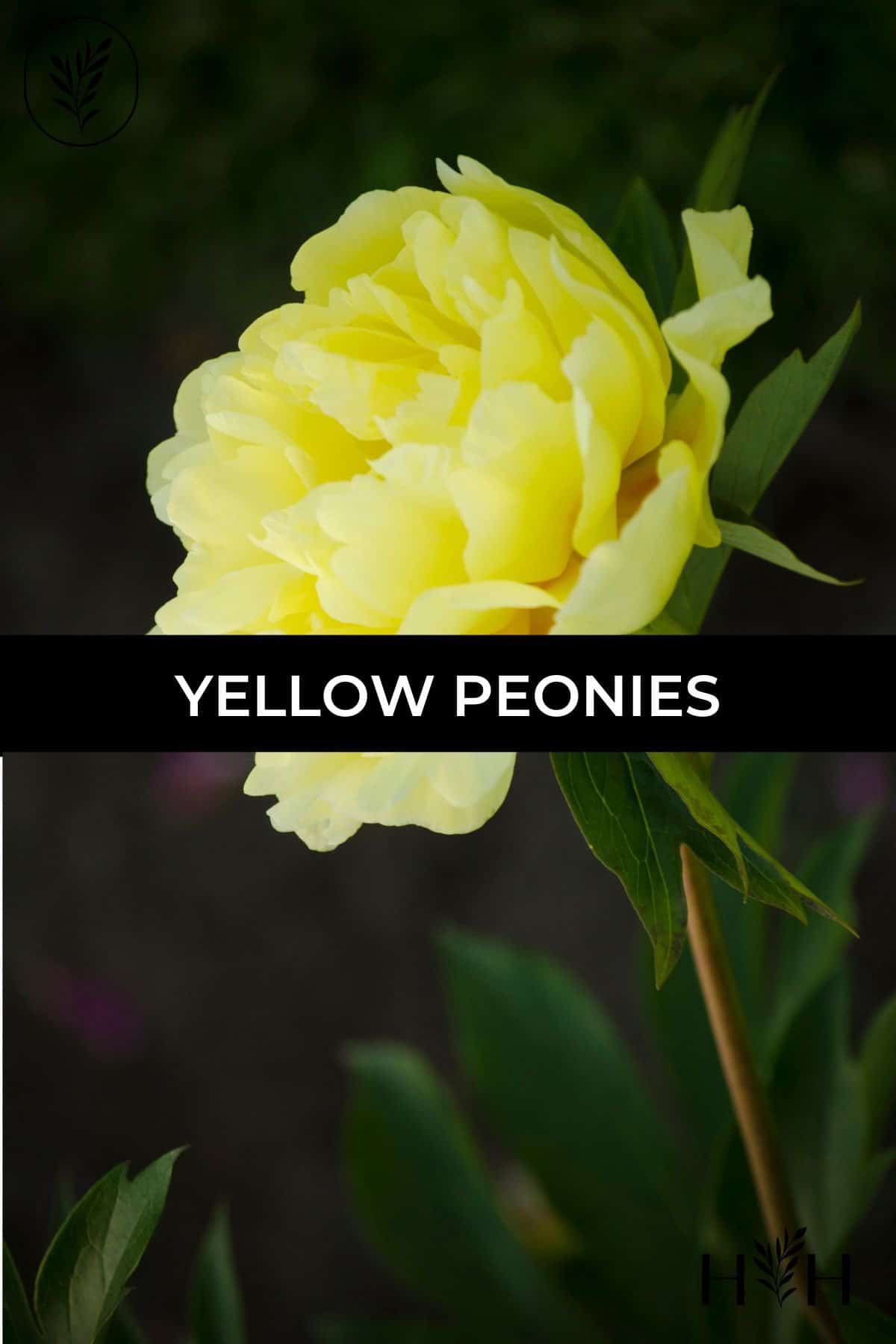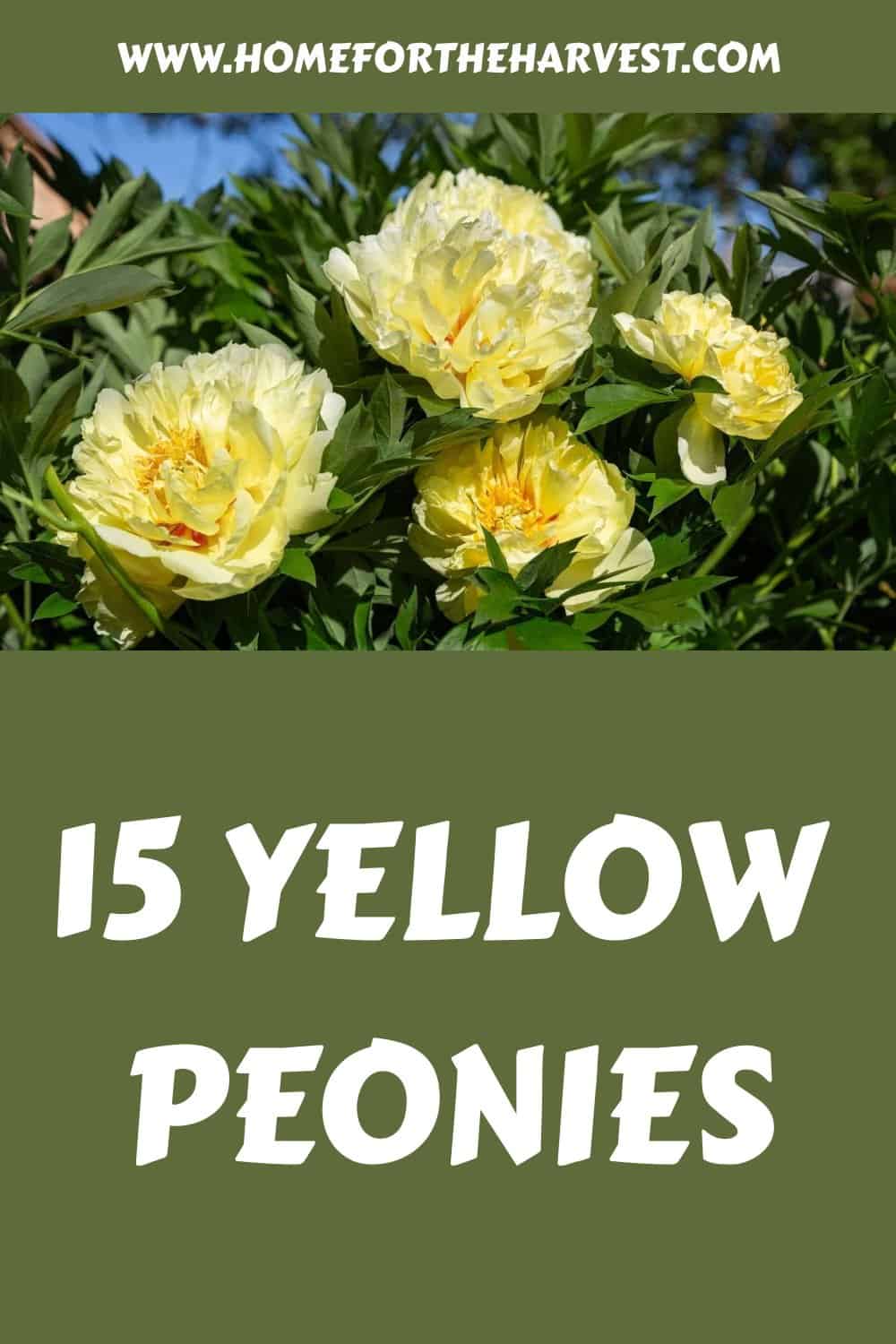Yellow peonies are a rare, show-stopping sight in the perennial flower garden. While they are not very common, there are several standout yellow peony varieties, including Bartzella Peony and Goldilocks Peony. Read on to learn all about the best types of yellow peonies to add to your flower garden or next spring floral bouquet!
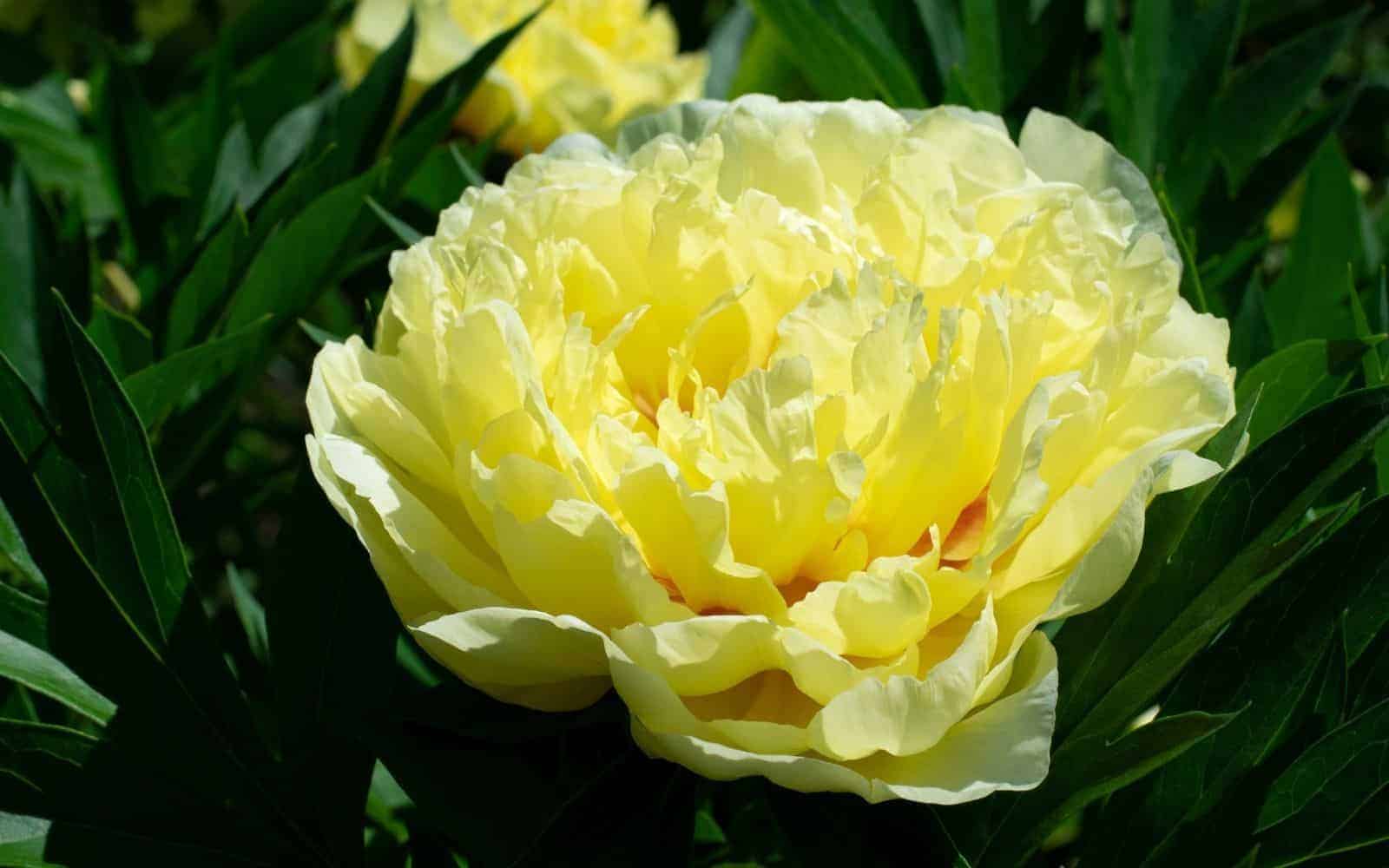
1. Bartzella Itoh peony
The Bartzella Itoh Peony is perhaps the most popular yellow peony for the garden. Bartzella is a vibrant yellow specialty intersectional peony with very large, scented, fluffy, lemon-yellow flowers, measuring 6″-8″ wide each. Plants are hardy with strong stems to hold up the big flowers. Mature plants can produce 60-80 flowers in a single season.
Bartzella Peony (Paeonia x ‘Bartzella’) plants can be grown in Zones 3-8. They tend to flower in late spring or early summer, depending on the local climate. These plants grow at a medium rate, reaching a mature height of 24″-36″ tall and a spread of 24″-36″ wide. The Bartzella Itoh Peony was developed by Roger F. Anderson of Fort Atkinson, Wisconsin (USA).
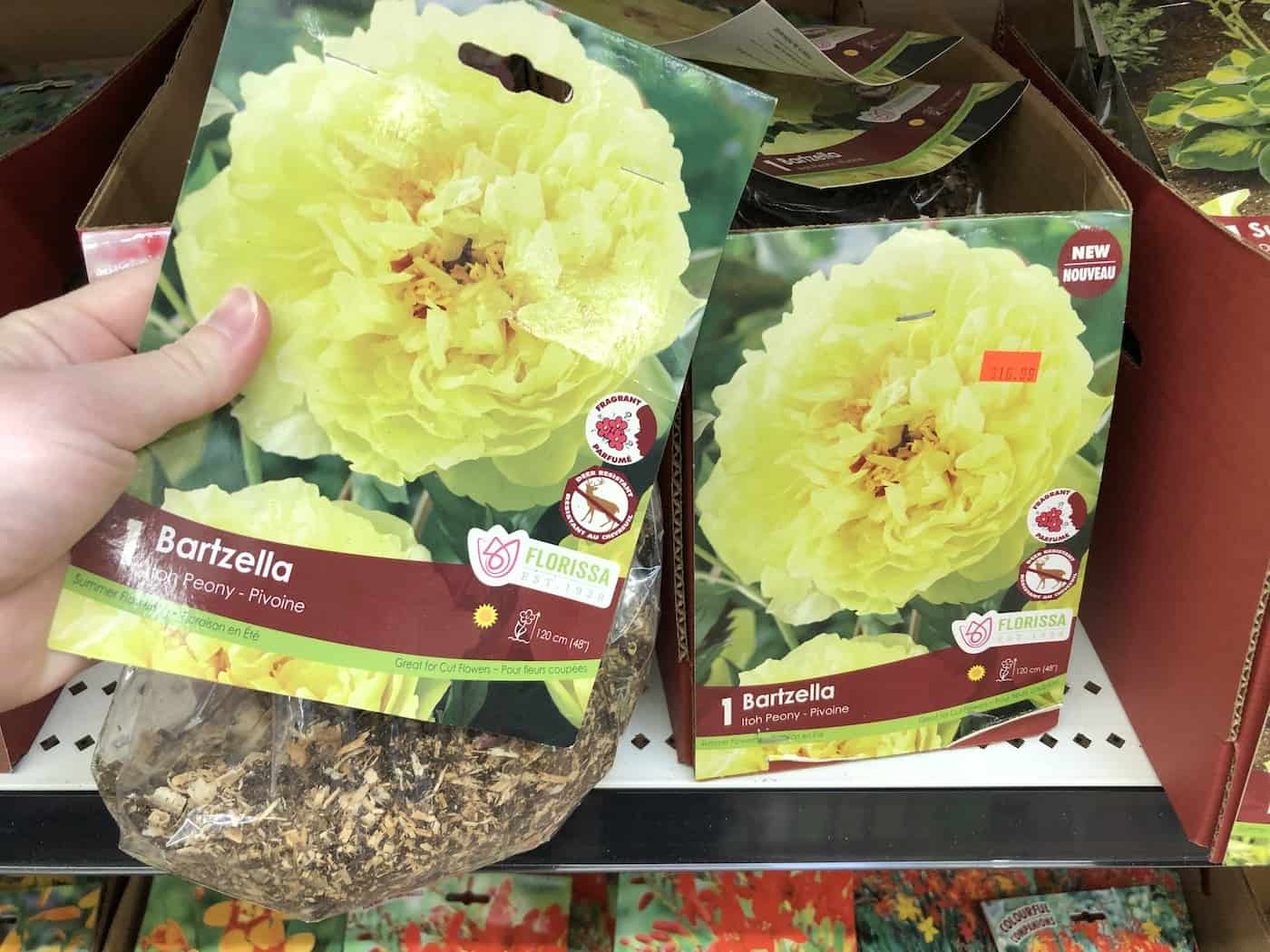
2. Goldilocks peony
Goldilocks Peony is a gorgeous double yellow bombe-type herbaceous peony. This peony has many layers of soft, cream-yellow petals, which have no fragrance. The light-yellow flowers tend to be anemone-form on young plants, maturing to bombe-type ball-shaped flowers on established plants.
The Goldilocks Peony (Paeonia ‘Goldilocks’) can be grown in Zones 3-8. They tend to flower in mid-spring (in the middle of peony season). Plants are slow-growing, eventually reaching a mature height of about 28″ tall. Plants typically grow to a spread of 30″-36″ wide. The Goldilocks Peony was bred by Ben Gilbertson of North Dakota (USA) and introduced in 1975.
3. High Noon tree peony
High Noon Tree Peony is a yellow tree peony known for being one of the easiest tree peonies to grow. The flowers are semi-double and have a lovely floral fragrance. The cupped petals are reminiscent of an old-fashioned rose, with a touch of pink at the petal base where they meet the center of the flower. Each flower is about 5″-6″ wide. Unlike most peonies, established High Noon peony plants can rebloom in August.
High Noon Tree Peonies (Paeonia suffruticosa ‘High Noon’) can be grown in Zones 4-7. They flower early in the peony season, typically blooming in early-mid spring. The plants grow slowly but can reach 36″-70″ tall depending on growing conditions. A single plant can reach 4′-5′ wide. The High Noon Tree Peony was bred by Arthur Percy Saunders of Clinton, New York (USA), and was introduced in 1952.
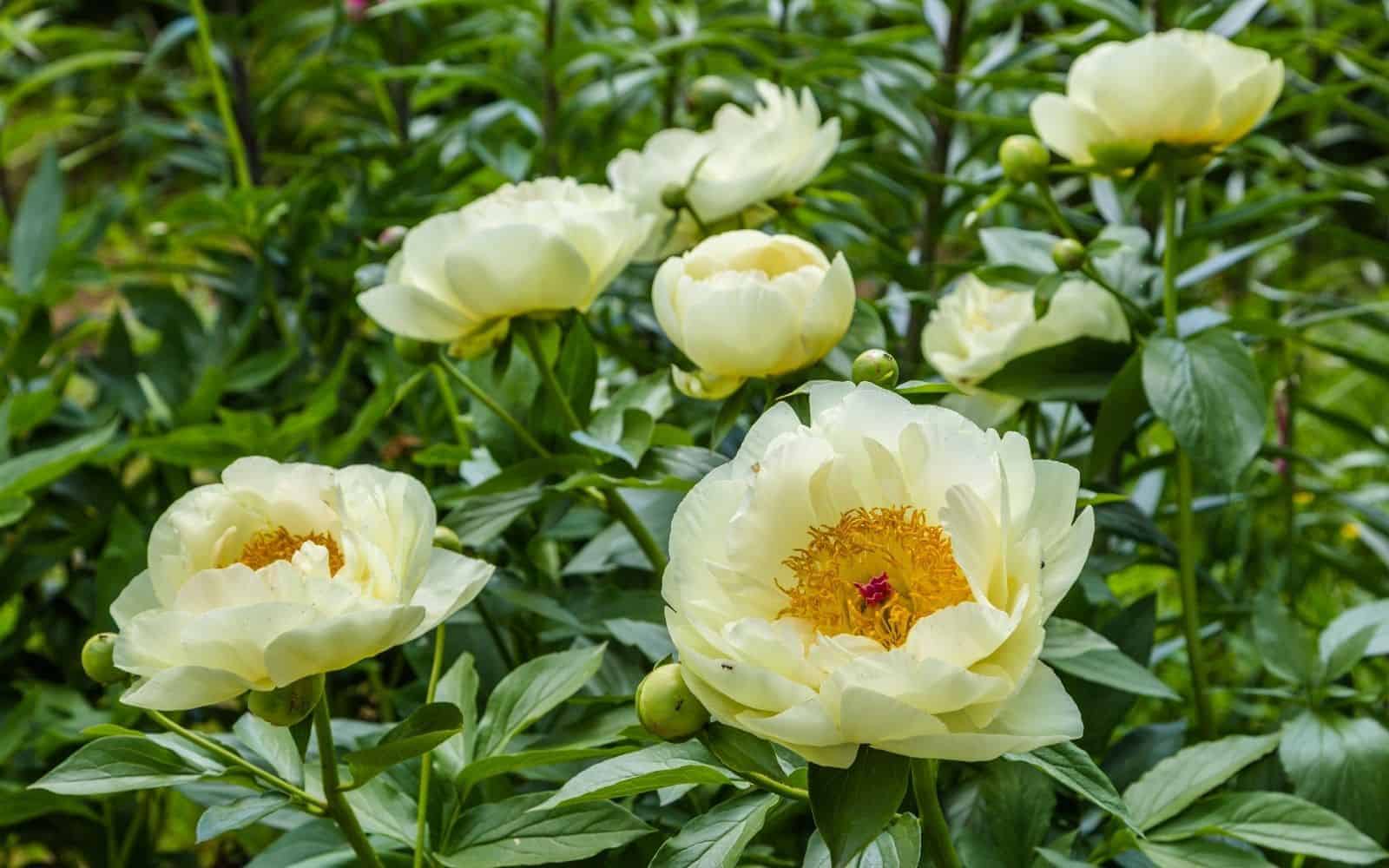
4. Lemon Chiffon peony
Lemon Chiffon Peony is a soft, light-yellow herbaceous peony with prominent golden center stamens. The ball-shaped flowers grow 5″-6″ wide with beautiful double petals and bright gold stamens. The plants have lovely deep green foliage and strong stems to hold up the heavy flowers.
The Lemon Chiffon Peony (Paeonia lactiflora ‘Lemon Chiffon’) can be grown in Zones 3-8. They flower in the middle of the peony season, typically in mid-late spring. Plants grow at a medium speed, reaching 32″ tall and 24″-36″ wide when mature. The Lemon Chiffon Peony was bred by David L. Reath of Vulcan, Michigan (USA), and was introduced in 1981.
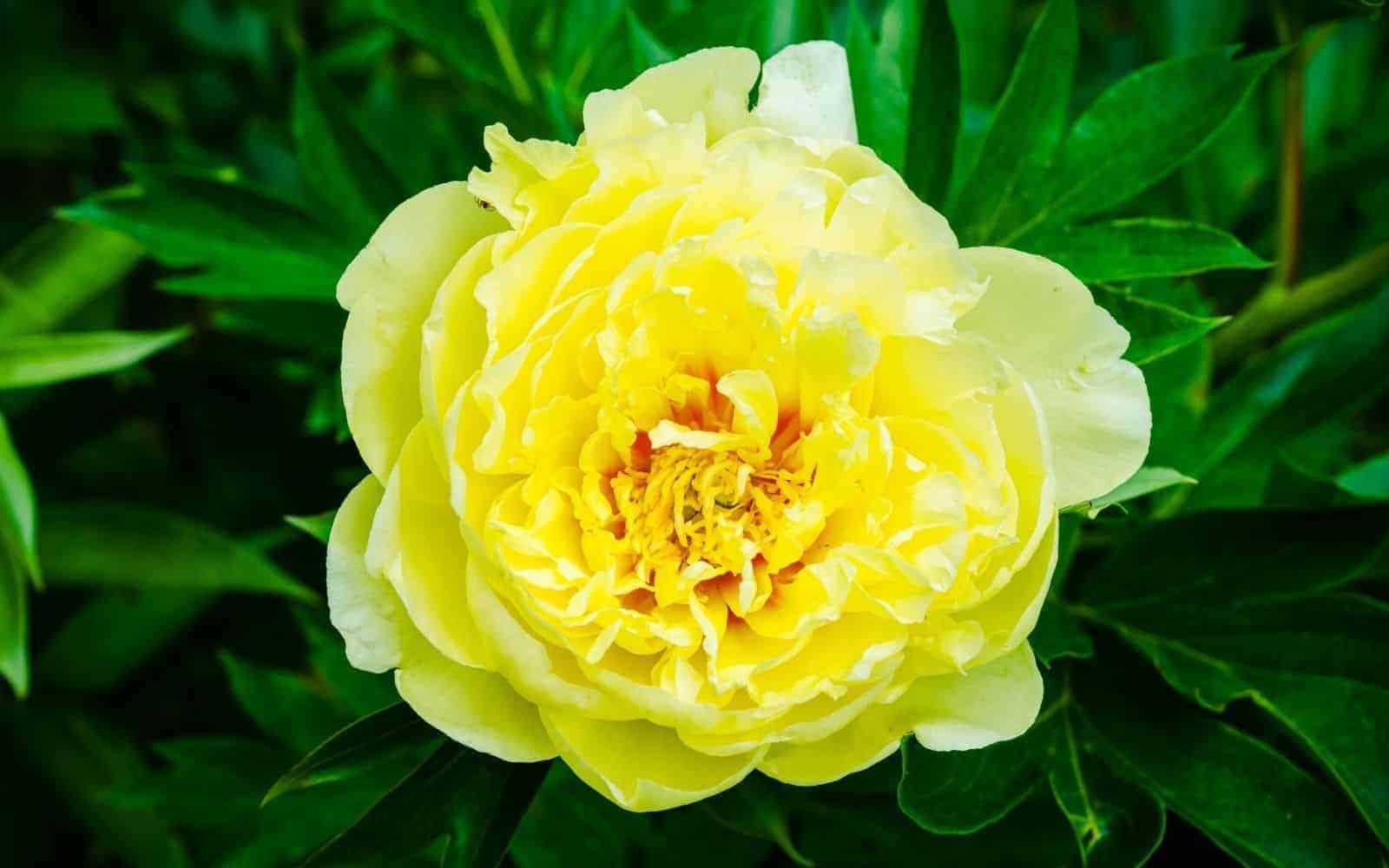
5. Garden Treasure Itoh peony
The Garden Treasure Itoh Peony is a yellow-gold intersectional semi-double peony. The large tree-peony-type flowers reach 6″-7″ wide each and are almost fully double on mature plants. The golden yellow peonies of Garden Treasure are highly fragrant. The foliage is dark green, somewhat glossy, and thick.
Garden Treasure Peony (Paeonia x ‘Garden Treasure’) can be grown in Zones 3-8. The plants grow slowly, typically reaching a height of about 27″ tall. Most plants reach a spread of about 36″ wide once established. The Garden Treasure Peony was bred by Don Hollingsworth of Maryville, Missouri (USA) and introduced in 1984.
6. Singing in the Rain Itoh peony
Singing in the Rain Itoh Peony is a fragrant yellow intersectional peony with peach-lemon petals. The semi-double flowers are large and can reach 6″ wide. This peony is known for blooming over a long period of time in comparison to other types of peonies. The flowers are a lemon-peach color as they unfurl, becoming creamy yellow and often maturing to an orange-salmon tone.
The Singing in the Rain Peony (Paeonia x ‘Singing in the Rain’) can be grown in Zones 3-8. Flowers bloom from early-mid spring until late spring and even into early summer. The plants have large leaves with a gorgeous dark green color. The slow-growing plants eventually reach up to 36″-40″ tall and 24″-36″ wide. The Singing in the Rain Peony was bred by Donald R. Smith of West Newtown, Massachusetts (USA), and introduced in 2002.
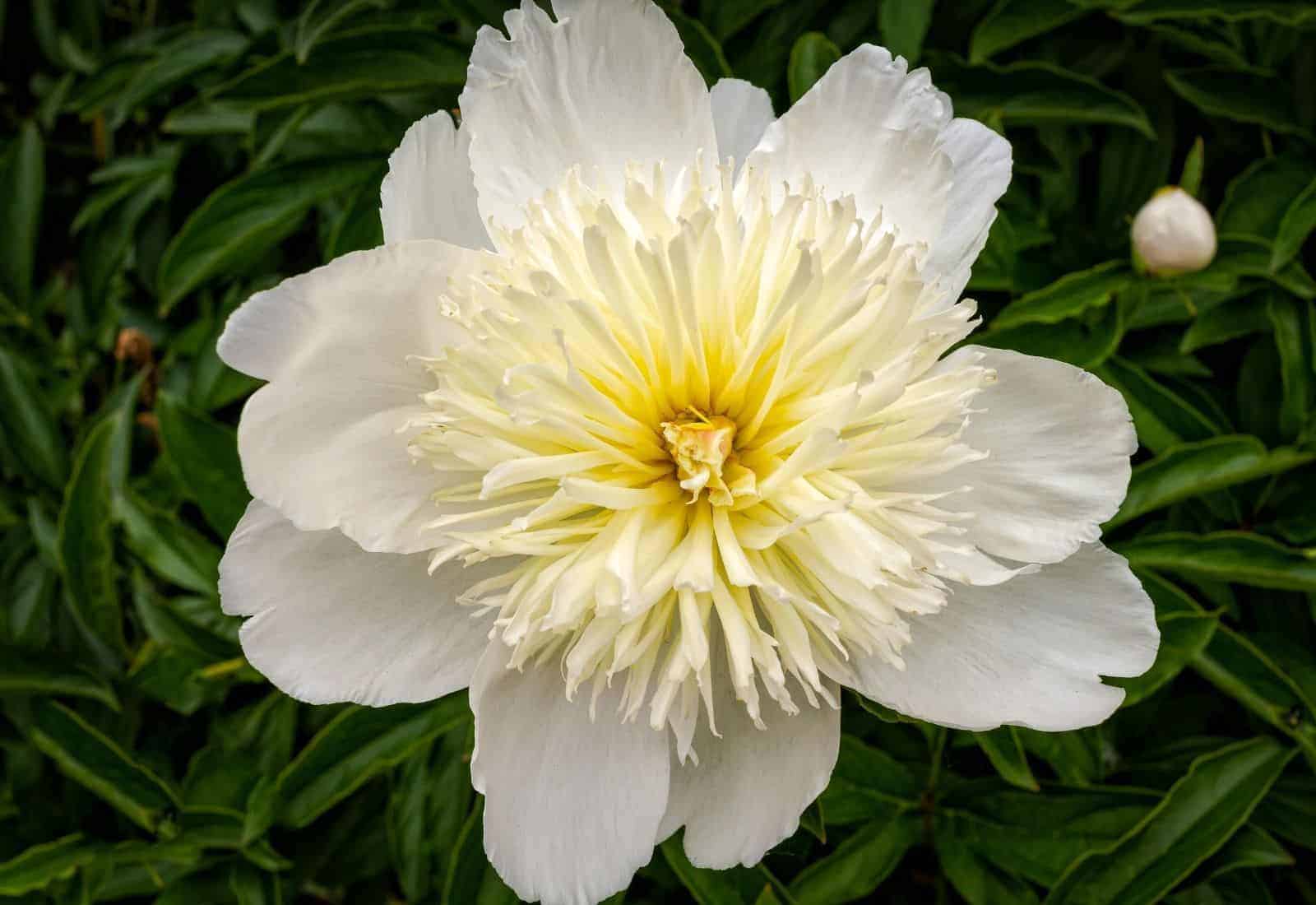
7. Honey Gold peony
Honey Gold Peony is a soft pink, yellow, and white fluffy herbaceous peony that makes excellent cut flowers. Fully double fragrant bombe-type blooms are 6″ wide and ball-shaped. The outer guard petals are creamy white, while the prominent center has yellow-gold staminodes, and the very middle blooms with pink petaloid. The soft yellow and pink shades are more pronounced on established plants and mature blooms.
The Honey Gold Peony (Paeonia lactiflora ‘Honey Gold’) can be grown in Zones 3-8. These plants grow slowly, reaching a height of 30″ tall and an eventual spread of 23″-36″ wide. The Honey Gold Peony was bred by Carl G. Klehm of South Barrington, Illinois (USA), and introduced in 1970.
8. Jan van Leeuwen peony
Jan van Leeuwen Peony is an elegant heirloom Japanese-type herbaceous peony with white petals and a striking yellow center. These easy-care plants have strong stems, dense green foliage, and minimal care requirements. The bowl-shaped blooms are about 5″ wide.
The Jan van Leeuwen Peony (Paeonia lactiflora ‘Jan van Leeuwen’) can be grown in Zones 3-8. This late-flowering variety typically blooms in early summer. Plants grow at a medium rate, typically reaching 34″-36″ tall and 24″-36″ wide. The Jan van Leeuwen Peony was bred by Leonard van Leeuwen of Sassenheim, Netherlands in 1928.
9. Lollipop Itoh peony
Lollipop Itoh Peony is a striking intersectional peony with yellow petals striped with red streaks. This gorgeous semi-double to double flowers really do look like candy! Each flower is about 6″ wide. Stripes become a deeper pink as blooms mature. These showy flowers are very attractive to beneficial pollinators.
The Lollipop Peony (Paeonia x ‘Lollipop’) can be grown in Zones 3-8. Plants bloom in the middle of peony season, generally in mid-late spring. These slow-medium growing plants reach 26″-30″ tall and mature to a spread of 24″-36″ wide. The Lollipop Peony was bred by Roger F. Anderson of Fort Atkinson, Wisconsin (USA), who also developed the famous Bartzella Yellow Peony (see above).
10. Top Brass peony
Top Brass Peony is a double bombe-type cream-white herbaceous peony with a canary-yellow ring of staminodes around the center. These tall, fluffy, sweetly-scented blooms are large, reaching 6″-7″ wide. Plants bloom prolifically and have attractive glossy green foliage.
The Top Brass Peony (Paeonia lactiflora ‘Top Brass’) can be grown in Zones 3-8. The plants grow slowly, reaching 28″-32″ tall and 32″-36″ wide. The Top Brass Peony was bred by Carl G. Klehm of South Barrington, Illinois (USA), and introduced in 1968. Carl Klehm also bred the beautiful Honey Gold Peony, described above.
11. Bowl of Cream peony
Bowl of Cream Peony is a very large cream-colored herbaceous double peony. The flowers are enormous, reaching 9″-10″ wide each on established plants. The petals are creamy yellow-white with golden stamens hidden between the petals. The plants have highly-ornamental dark green foliage and strong stems to hold up the massive blooms.
The Bowl of Cream Peony (Paeonia lactiflora ‘Bowl of Cream’) can be grown in Zones 3-8. Plants flower in the middle of peony season, typically late spring to early summer. The plants are slow-growing, reaching 30″-32″ tall and 30″-36″ wide. The Bowl of Cream Peony was bred by American peony breeder Carl G. Klehm of South Barrington, Illinois (USA), and introduced in 1963.
12. Butter Bowl peony
The Butter Bowl Peony is a bicolor pink and yellow Japanese-type herbaceous peony. The showy flowers have pink outer guard petals and yellow ruffled staminodes in the center. Blooms are highly scented and about 6″ wide each, attracting beneficial pollinators.
The Butter Bowl Peony (Paeonia ‘Butter Bowl’) can be grown in Zones 3-8. Plants bloom in the middle of the peony season, typically late spring to early summer. The plants grow 30″-36″ tall and eventually reach a spread of 32″-36″ wide. The Butter Bowl Peony was bred by Reno Rosefield of Tigard, Oregon (USA), and was likely introduced in the 1930s or 1940’s.
13. Blush Queen peony
The Blush Queen Peony is a soft yellow double herbaceous peony with hints of pink in the center. These giant flowers reach 8″-10″ across mature plants. The foliage is medium green.
The Blush Queen Peony (Paeonia ‘Blush Queen’) can be grown in Zones 3-9. Plants bloom in the middle of the peony season, generally flowering in late spring or early summer (depending on the local climate). Plants grow to 36″-42″ tall and about 36″ wide. The Blush Queen Peony was bred by Aart Hoogendoorn of Boskoop, Netherlands, and was introduced in 1949. Hoogendoorn is well-known for developing the popular Bowl of Beauty Peony.
14. Early Glow peony
Early Glow Peony is a single cream-yellow herbaceous peony with prominent yellow stamens. Flowers are delicate and large, about 6″ wide. This hybrid peony is easy to grow and has ornamental green foliage forming a bush shape after the plant flowers.
The Early Glow Peony (Paeonia ‘Early Glow’) can be grown in Zones 3-8. Plants reach about 30″ tall and 30″-34″ wide. The Early Glow Peony was bred by Don Hollingsworth of Maryville, Missouri (USA and introduced in 1992. Hollingsworth also bred the popular ‘Garden Treasure’ yellow peony (see above).
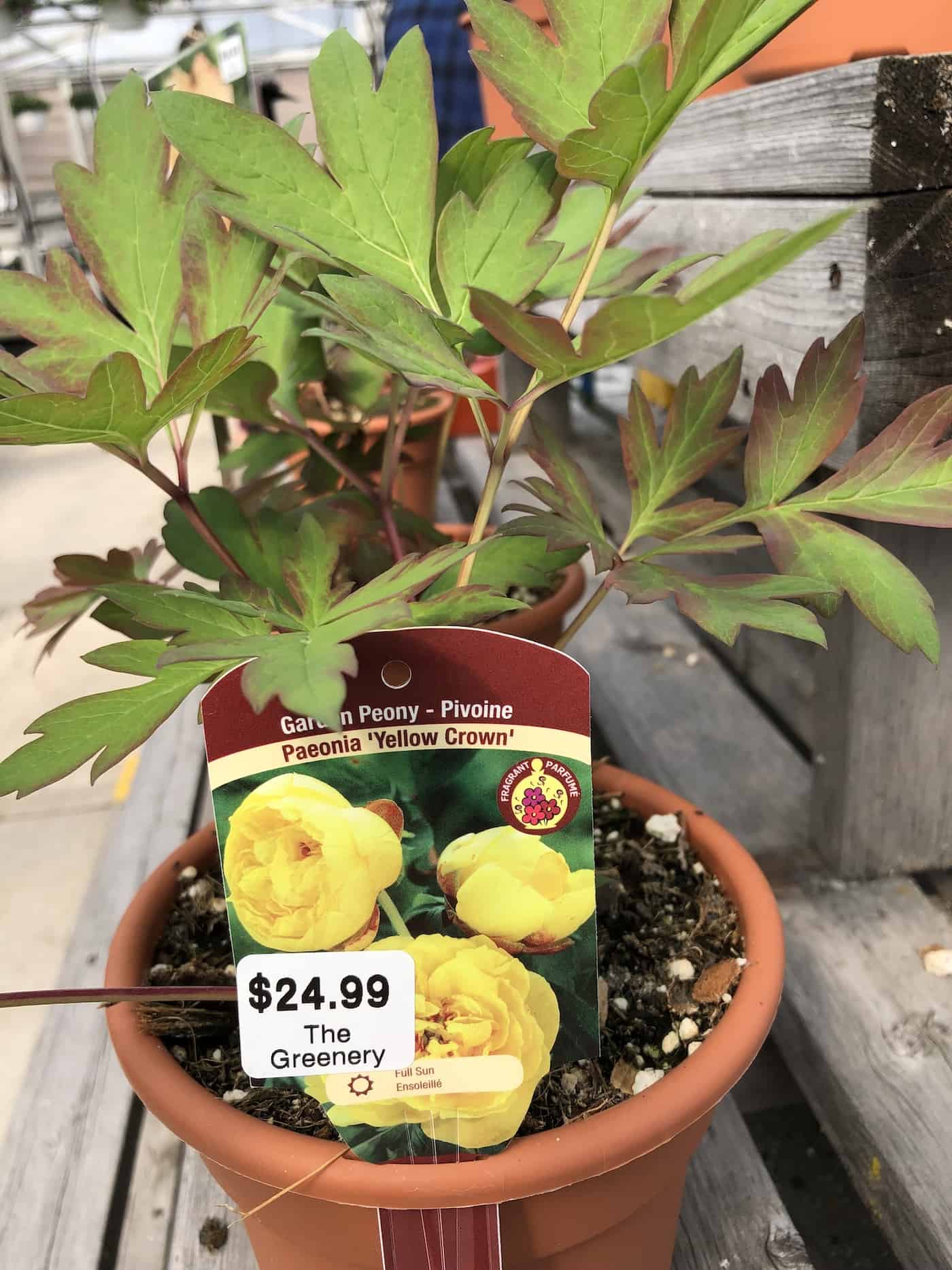
15. Yellow Crown peony
Yellow Crown Peony is an Itoh peony bred by Itoh in the early 1960s. The ball-shaped yellow flowers have many layers of yellow petals that turn to red in the very center of the bloom. This variety is a cross between the Kakoden herbaceous peony and the Alice Harding tree peony. Yellow Crown plants reach 24″-36″ tall and have tree peony foliage.
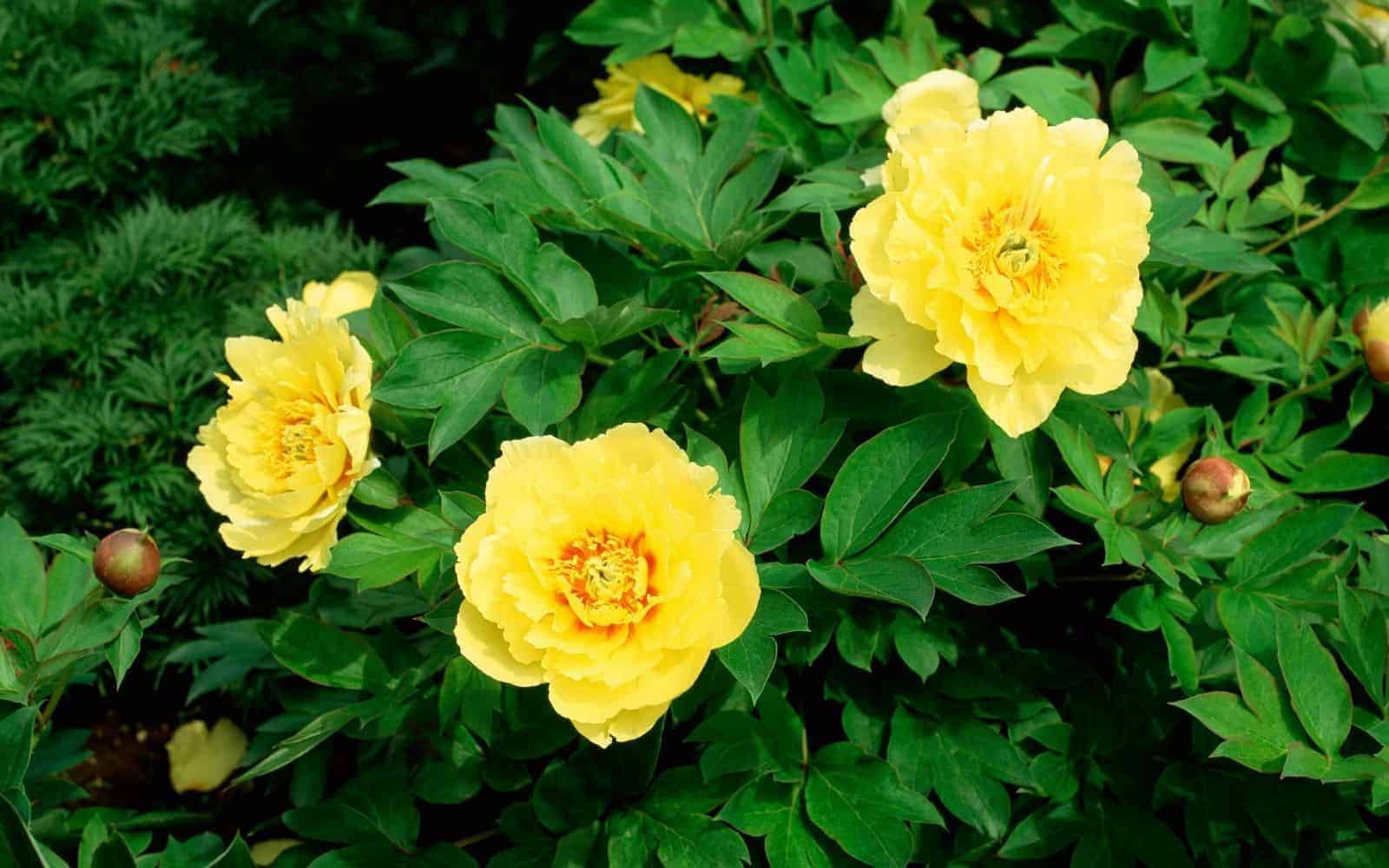
More yellow peony varieties
Here are even more yellow peony varieties to choose from:
- Alice Harding Peony
- Alice in Wonderland Peony
- Amy Jo Peony
- Autumn Harvest Peony
- Border Charm Peony
- Claire de Lune Peony
- Daystar Peony
- Europa Peony
- Gentle Flash Peony
- Heavenly Sugar Cookie Peony
- Huang Jin Lun Peony
- John’s Dream Peony
- Le Printemps Peony
- Majesty’s Crown Peony
- Majesty’s Cup Peony
- Nova Peony
- Nova II Peony
- Oriental Gold Peony
- Prairie Charm Peony
- Prairie Moon Peony
- Quitzin Peony
- Seidl’s Super Peony
- Seneca Yellow Bird Peony
- Sonoma YeDo Peony
- Summer Glow Peony
- Wonderous Shine Peony
- Yellow Crown Peony
